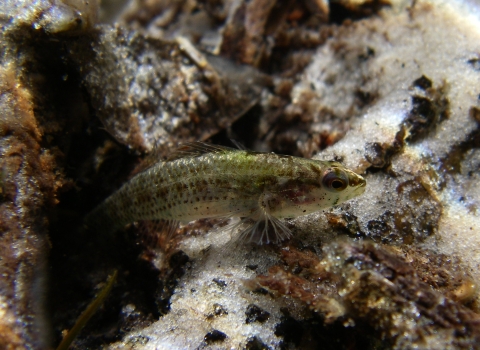When the Okaloosa darter was listed as an endangered species in 1973 only 1,500 were left. It was on the brink of extinction. This year, on the 50th anniversary of the Endangered Species Act, the population has grown to more than 600,000 and the U.S. Fish and Wildlife Service took it off the list in July.
Saving a little fish was no small feat.
“This darter is a measure of the entire ecosystem’s health,” said Bill Tate, lead biologist for the darter’s recovery. “We are on Florida’s Emerald Coast, and we need to keep it beautiful. The creeks should be as crystal clear as rainwater.” Tate has learned a lot about the tiny creatures in nearly two decades. He routinely dons a wetsuit to spend hours snorkeling along the edges of fast-moving meandering streams while catching, tagging, and counting the darters. Over the years he has tallied tens of thousands.
The two-inch fish might not be as showy as most North American darters, but in the sunlight, flecks of gold sparkle on its yellow and green body. And, when you catch one, you really can see a twinkle in its eye according to Tate and other researchers. The Okaloosa darter is a homebody, rarely crossing the center of the stream to reach the other bank.
The entire population inhabits six clear, sand-filtered streams draining into Choctawhatchee Bay bayous in northwest Florida. The darters are bottom dwellers that hide in roots, sticks, or vegetation where they can “dart” out to dine on mayfly nymphs, caddisfly, or midge larvae. They don’t live a long time, usually less than five years. Yet researchers tracked a marked darter in the same spot in the same stream for eight years, the longest life span of any wild-caught darter.
Eglin Air Force Base manages the land where 98% of all Okaloosa darters live. Base biologists and natural resource managers, Florida Fish and Wildlife Conservation Commission, USGS, and Loyola University researchers collaborated with the Service to restore habitat and recover the fish. Over decades they dug out tons of sediment, removed fish barriers, and reconnected streams. Now that it’s delisted, what will keep the Okaloosa darter from sliding back into decline?
A “post-delisting monitoring plan” covers at least five years and defines actions that could threaten the darter or require emergency relisting. Tate and the “Okaloosa darter working group” developed the plan, which outlines how often the darter and water quality will be sampled and assign responsibilities. For instance, they established a new prescribed fire regimen after finding that shady trees reduce vegetation where the darters shelter and spawn. “We need to make sure the species continues to thrive,” Tate said. He won’t be hanging up his wet suit any time soon; one member of the group has retired; and two others are talking seriously about it as well. “So, I’ll be holding the reins in the post-delisting world,” he said.






